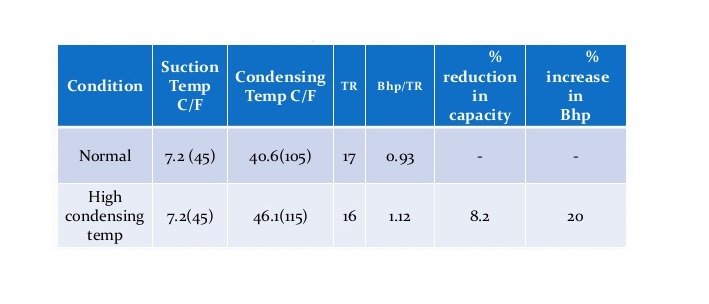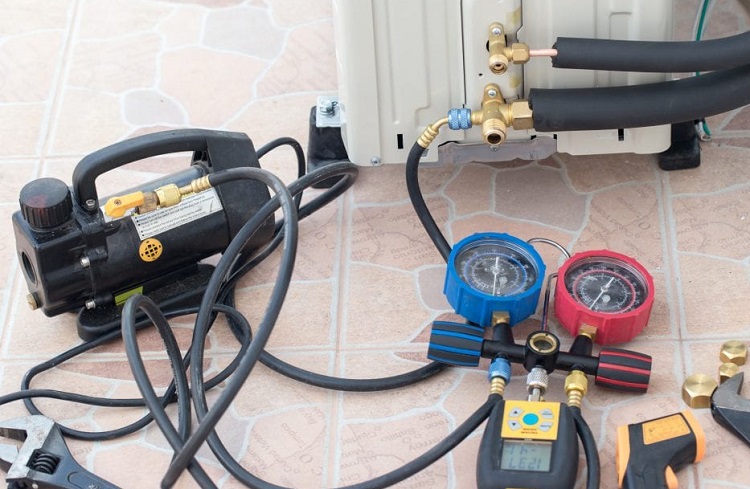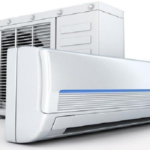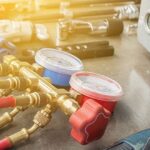There are many benefits of developing and following hvac preventive maintenance program, the most important of them include to anticipate possible failure and to operate the hvac plant at design efficiency ultimately saving the energy.
A good air conditioning AC preventive maintenance program shall cover many aspects like cleaning, tuning, repairing and monitoring, some of them include:
Strictly following the ac maintenance schedule in order to keep the heat transfer surfaces, air filters and air handling equipment clean, free of dust, scale and corrosion. This is important because in the case of a heat transfer equipment, even a small amount of fouling of the heat transfer surfaces can reduce its efficiency hence affecting the complete system’s capacity and increase power consumption.
Regular lubrication of moving parts at the right time and with best quality lubricants. Remember that too much of the lubricant is as bad as too little of it.
Inspection and checking the operation of safety and operating controls periodically. It is imperative to verify that all safety controls are functioning properly to protect the equipment from damage and protection against abnormal working conditions.
Refrigerant leaks monitoring is another important practice of a good air conditioning preventive maintenance program. In addition to the cost of the refrigerants, a system running short of the refrigerant can become faulty due to excessive cylinder head pressure. On the other hand, in the case of hermetically sealed units refrigerant leakage can also result in compressor motor burnt out and system contamination.
Controlling and monitoring the development of vibration. Vibration is one major factor contributing to refrigerant leaks, therefore this is always part of routine inspections of HVAC system.
Mandatory and systematic maintenance of daily, weekly and monthly readings of the plant. A faithful approach for recording the logs will always serve as basis for troubleshooting the equipment.
Seasonal periodical overhauling of the equipment’s and components. It is important to carry out the recommended periodical overhaul of equipment. For example, if the estimated life of a bearing is 7000 running hours and it is replaced when the equipment has run for 7000 hours, it is a relatively simple and comparatively inexpensive job that can be planned and done. However if this is not done, crankshaft journals can get effected, necessitating costly and time consuming repairs.
General Points to Help HVAC Preventive Maintenance Process
A partially blocked condenser, water filter or cooling tower spray nozzles increases the discharge pressure/temp of the compressor, contributing to increased power consumption for much less cooling effect.
You can see the relations in the following table.

Factors Affecting Efficiency of AC Compressor
Below are various factors, which affect the capacity and the power requirement of a compressor.
Sub cooling of the liquid:
When the compressor runs at a constant speed, the pressures and superheating remains the same, the power requirement of the compressor will not change, whether the liquid is sub cooled or not. But by sub cooling, the net refrigeration effect of the refrigerant increases and so the refrigeration capacity increases for the same horse power.
Hence horse power per ton of the AC comes down when sub cooling of the liquid is not accomplished by the compressor. Arrangements for sub-cooling the liquid are usually incorporated in the system.
Discharge pressure:
If the discharge pressure goes up ( this can happen when condenser surface gets fouled up) compression ratio also rises, consequently the capacity of the compressor comes down due to the effect of clearance volume. However, more power will be required to compress the gas to a higher discharge pressure and thus power requirement per ton increases.
Suction pressure:
As the suction pressure comes down, the compressor capacity drops. This is due to the effect of CR, the CV and decrease in the density of the vapour. Hence the hp per ton increases .
Superheating of suction gas:
As the superheat increases, the compressor capacity drops due to reduction in the density of the gas. The result is an increase in the hp per ton.
Pressure drop in suction line:
This is due to a drop in suction pressure.
Reduction of Volumetric efficiency
If the compression ratio increases, the volumetric efficiency of the compressor comes down, and so the compressor capacity gets affected. The compression ratio can increase if the discharge pressure increases or the suction pressure comes down or both happen together.
Above problems can be avoided easily by following hvac preventive maintenance program at company and local/domestic level.
Reasons for increase in Discharge pressure
Clogging of air cooled condenser:
The fins of the air cooled condenser can get clogged with dust and lint. This can increase resistance to air flow thus reducing the air quantity for the condenser. The film of dust also decreases the heat-transfer efficiency. The result is increased discharge pressure.
Fouling of tubes in water cooled condenser:
The cooling tower or pond being located out in the open collects lot of atmospheric dust and muck which end up in the condenser fouling the water tubes. The impeller passages in the condenser pump too can get chocked , there by reducing the water quantity through the condenser. The result of all these is increased discharge pressure.
Scale formation in condenser water tubes:
The impurities and salts present in the water can precipitate as scale in the condenser water tubes. The scale formation is more when the temperature of the tube surfaces increases. Few upper side tubes of the water cooled condenser are subjected to the highest temperature as the hot super heated discharge gas gets cooled on impinging on them. So scale formation in these tubes is faster and thicker. As scale offers more resistance to heat transfer, the heat exchange between the refrigerant and water in the tubes gets affected. This results higher condensing temperature / discharge pressure.
Overcharge of refrigerant in the system:
The excess liquid refrigerant accumulates occupying more volume in the condenser thereby reducing the heat transfer area available for the high pressure refrigerant gas to be cooled and condensed.
This causes the discharge pressure / the condensing temperature to rise, more the overcharge higher will be the rise in discharge pressure / condensing temperature.
There will be a slight, but distinct temperature difference between the portion of the condenser where there is liquid and from the portion filled with vapor.
One can feel this physically by slowly moving the hand over the shell of the water-cool condenser and by feeling the U bends of the air-cool condenser coil.
Presence of non-condensable in the system is also one reason of increase in discharge pressure.
Steps to Prevent an increase in Discharge Pressure in HVAC Equipment
Clean the air–cooled condensers regularly using the compressed air or an air blower. If the fins are badly choked, clean with a high pressure water pump and cleaning solution.
Clean the cooling tower water strainers daily and the strainers in the water system every week. When the strainers get very much clogged up, they can never be fully cleaned. They should be replaced. Drain and clean the cooling tower tank periodically, say once in fortnight.
Clean and descale condenser water tubes periodically.
Non condensable can find their way into the system when it is open for repairs. Therefore whenever a system is open evacuate with a vacuum pump before charging the system again. You can judge the presence of non-condensable from the standing pressure of the system. Pump down the system and cool down the condenser to the outside temperature. In air-cool type condensers run the condensers fan alone to achieve this. In water-cool type condensers run the water pump to bring down the temp of the condenser to level of that water.
Remove excess refrigerant.
Reasons for Reduction in Suction pressure – HVAC Preventive Maintenance Tip
- Fouling of evaporator surface
- Throttling devices failure/improper adjustments
- Reduction of air quantity over cooling coils
- Clogging suction Filters of high Capacity compressors
- Shortage of refrigerant
- Clogged liquid line strainers
Steps to prevent decrease in suction pressure
- Wash the all cooling coils periodically
- Checking of throttling devices properly
- Dampers checked for proper fixing and free movement
- Cleaning of Air filters once a week
- Suction filters of Compressor periodically inspected / checked
- Leak testing for refrigerant leaks
Troubleshooting Liquid flood back
Liquid flood back to compressor in some times during operation from the evaporator to the compressor can dilute oil appreciably and cause damage to bearings. If liquid refrigerant enters compressor crankcase, it dilutes the oil resulting in poor lubrication of bearings.
Reasons for Liquid Flood back
Improper adjustment of expansion valve
Dirty cooling coil/ chiller
Reduced air flow over cooling coils
Reduced water flow in chillers
Temp. of crankcase falling below cooling coil temperature
Liquid draining by gravity due to improper layout of refrigerant piping
Excessive suction gas superheat, in addition to reducing the compressor capacity to some extent, cause excessive heating of the compressor body/head.
How to Prevent Excessive suction gas superheat
- Arrange good ventilation in the plant room
- Lubricate shaft seals properly
- Clean oil and oil lines in compressor
Checking Evaporator (Chiller) Efficiency:
The leaving temperature difference (LTD) is the simplest of checking the evaporator performance.
LTD = Outlet temperature of the fluid – Temp of the refrigerant in the evaporator(Saturation temperature of the refrigerant corresponding to the evaporator pressure)
Tips for getting maximum efficiency from evaporator:
- Clean /wash the evaporator coils periodically
- Clean strainers and filters in the water system regularly
- Brush water tubes in flooded chillers at least once in a year
- Check and rectify oil return problems
To summarize the tips for hvac preventive maintenance, it is best to develop a comprehensive maintenance program and holistically doing the ac maintenance work accordingly.



Pingback: HVAC Operation and Maintenance Tips